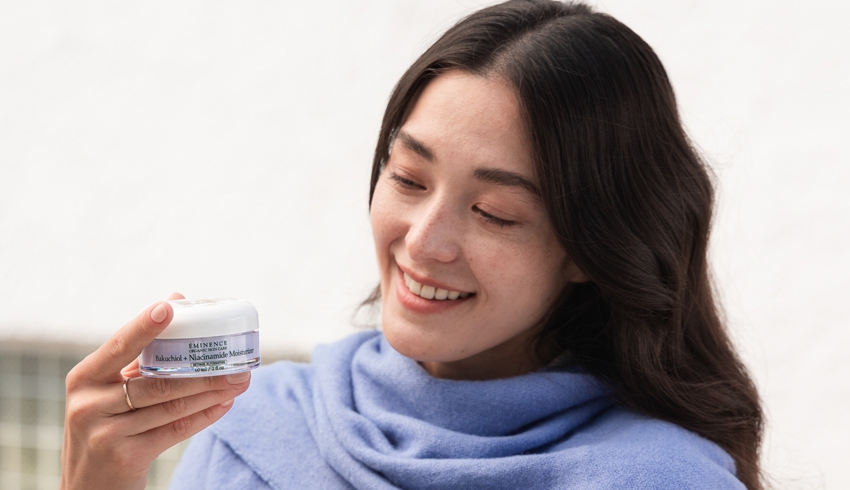
Does your skin feel worn out, like it’s struggling to keep up with your busy life? Maybe it’s persistent redness that won’t fade, dryness that feels impossible to soothe, or that unmistakable lack of vibrancy. If so, panthenol might be what your routine is missing.
More than just a hydrator, panthenol works to calm irritation, support your skin’s barrier natural function and restore much-needed moisture. Fun fact: it’s also a game changer for hair — smoothing strands, reducing breakage and boosting shine.
Let’s take a closer look at how panthenol works and why it’s earned a permanent place in so many skin and hair care formulas.
What Does Panthenol Do For The Skin?
Panthenol, also called provitamin B5, is a humectant that draws moisture into the skin, helping to maintain hydration and improve elasticity. According to a study published in the Journal of Cosmetic Science, panthenol significantly decreases transepidermal water loss (TEWL), reinforcing the skin barrier and reducing moisture loss.
Research also highlights its anti-inflammatory properties, suggesting that panthenol can soothe redness and irritation, making it beneficial for sensitive and acne-prone skin. Additionally, clinical trials have shown that panthenol supports the skin while wounds and the skin repair itself.
What Is Panthenol & How Does It Work?
Panthenol is a water-soluble compound derived from pantothenic acid, also known as vitamin B5. It works by drawing water into the deeper layers of the skin, creating a smooth, hydrated barrier while supporting the skin’s natural ability to retain moisture.
Let’s take a closer look at its key benefits.
Moisturizing & Skin Barrier Strengthening Abilities
Panthenol acts as a humectant, which means it draws water from the environment and binds it to the skin, ensuring long-lasting hydration. Panthenol also reduces transepidermal water loss (TEWL), strengthening the skin barrier and preventing moisture from escaping.
Anti-Inflammatory Ingredient
Panthenol is known for its anti-inflammatory properties. According to research, it can soothe the appearance of redness and irritation, making it an ideal ingredient for sensitive or inflammed skin.
Promotes Wound Healing
Panthenol is also a common ingredient used to support skin while wounds heal and to soothe, sunburns and skin post-procedure.
Why Panthenol Deserves A Spot In Your Routine
Panthenol is more than just a supportive ingredient — it’s a proven multitasker. Here’s how it can elevate your skin care routine:
1. Delivers Lasting Hydration To Combat Dryness
Panthenol works as a humectant, attracting water molecules from the environment and binding them to your skin. Panthenol not only hydrates but also helps prevent transepidermal water loss (TEWL), locking in lasting moisture. This ability makes it a vital ingredient in products for dry or dehydrated skin. Soothes Redness & Irritation
If your skin is prone to redness or sensitivity, panthenol’s anti-inflammatory properties can provide relief. Panthenol reduces visible irritation by supporting the end of the skin’s inflammatory response. This makes it ideal for use on sensitive skin and post-procedure care.
2. Supports Healing Skin & Recovery
Damaged skin, whether from sunburn, over-exfoliation or environmental stress, requires a gentle yet effective approach to repair. Panthenol supports keratinocyte (skin cell) regeneration, which encourages accelerated wound healing and the skin barrier resilience — why it’s often recommended in post-sun or recovery products. You can read more about it here.
3. Compatible With All Skin Types
Unlike some heavier moisturizing agents, panthenol hydrates without clogging pores, making it suitable for oily and acne-prone skin. For dry or combination skin, it works to improve moisture retention and help the skin maintain a balanced-looking complexion.
4. Promotes A Youthful, Resilient Appearance
Hydration and barrier support are critical for maintaining elasticity and reducing the visible signs of aging. Panthenol’s ability to improve skin texture and smooth fine lines makes it a valuable ingredient for those seeking long-term skin health.
How Panthenol Compares To Other Hydrating Ingredients
Panthenol is a standout ingredient, but how does it stack up against other popular hydration heroes in skin care?
Let’s explore how it compares:
1. Panthenol Vs. Stone Crop
Stone crop is a succulent plant celebrated for its hydrating and nourishing properties, particularly beneficial for uneven skin tones. Its natural moisturizing properties help to replenish moisture, resulting in a smoother and more supple complexion.
While both ingredients provide hydration, panthenol focuses on moisture retention and barrier strengthening, whereas stone crop offers benefits in skin tone improvement.
Products like our Stone Crop Hydrating Mist utilize stone crop to hydrate and nourish the look of the skin. This ingredient helps to brighten the appearance of the skin and increase the look of hydration leaving your skin looking more moisturized and smooth.
2. Panthenol Vs. Hyaluronic Acid
Hyaluronic acid is another powerful humectant capable of holding up to 1000 times its weight in water, providing intense hydration. However, most skin care featuring hyaluronic acid includes it in its larger molecular form, meaning that primarily affects the skin’s surface, offering temporary hydration.
Panthenol penetrates more deeply. As mentioned, upon application, it converts into vitamin B5, which allows for deeper penetration into the skin layers.
3. Panthenol Vs. Glycerin
Glycerin’s primarily function is to attract and retain moisture in the outer skin layers, enhancing hydration and maintaining skin elasticity. Glycerin offers immediate surface hydration and softening effects, while panthenol delivers deeper hydration, encouraging a balanced skin barrier.
4. Panthenol Vs. Aloe Vera
Aloe vera is renowned for its soothing and hydrating properties, often used to calm irritated skin. This ingredient has been used to treat a wide range of skin disorders because it is soothing, moisturizing and cooling to the skin. Aloe vera offers antioxidant benefits and a refreshing effect, making it particularly effective for soothing sunburns and minor skin irritations.
While both panthenol and aloe vera provide hydration and support skin healing, panthenol uniquely contributes to skin barrier reinforcement and visible inflammation reduction.
Is Panthenol Good for Hair?
Panthenol isn’t just a hero for skin — it’s also a widely loved ingredient in hair care. Its hydrating, strengthening and smoothing properties make it an excellent addition to shampoos, conditioners and treatments.
1. Deep Moisture For Dry Hair
Panthenol acts as a humectant in hair products, drawing moisture into the hair shaft and locking it in. This makes it ideal for combating dryness and improving hair manageability.
2. Strengthens & Repairs
When applied to hair, panthenol penetrates the cuticle to strengthen strands from within. It helps repair damage caused by heat styling, coloring and environmental stressors, leaving hair healthier and less prone to breakage.
3. Adds Shine & Smoothness
Panthenol coats the surface of the hair, creating a smooth, shiny finish. Its ability to reduce static and improve texture makes it a favorite for those seeking sleek, frizz-free styles.
4. Scalp Care Benefits
Panthenol also benefits the scalp by providing hydration and reducing irritation. It can be particularly helpful for individuals with dry or flaky scalps, as it soothes and supports the skin’s natural barrier.
Commonly Asked Questions About Panthenol
1. Is Panthenol Safe For Sensitive Skin?
Yes, panthenol is considered very safe for sensitive skin. Its soothing and anti-inflammatory properties help calm irritation and redness, making it ideal for those prone to sensitivity. It also strengthens the skin barrier, reducing the impact of external irritants.
2. Can Panthenol Replace Hyaluronic Acid?
While both are excellent hydrating ingredients, they serve slightly different purposes. Most hyaluronic acid formulas provide immediate surface hydration by holding water on the skin’s surface, where as panthenol penetrates deeper into the skin, providing long-lasting hydration, barrier repair and anti-inflammatory benefits.
3. Does Panthenol Clog Pores?
No, panthenol is non-comedogenic, meaning it does not clog pores. Its lightweight texture makes it suitable for all skin types, including oily and acne-prone skin.
4. Can Panthenol Be Used with Active Ingredients?
Panthenol pairs well with active ingredients like niacinamide, hyaluronic acid and retinol. Its calming and hydrating properties help reduce the potential irritation caused by strong actives.
5. How Often Should I Use Panthenol?
Panthenol can be used daily in moisturizers, serums and treatments. Its gentle nature makes it safe for consistent use, even for those with sensitive skin.
Products You’ll Love
The Eminence Organics Bakuchiol + Niacinamide Moisturizer pairs panthenol with the unique combination of a retinol alternative bakuchiol and niacinamide. This combination deeply hydrates and improves the look of fine lines and wrinkles with lightweight, quenching moisture.
If you’d like to explore how panthenol can enhance your skin care routine, book a consultation with a licensed esthetician at an Eminence Organics Spa Partner near you.



